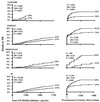Unstable angina and non-ST-segment elevation myocardial infarction: perspectives on combination therapy
- PMID: 11777152
- PMCID: PMC101203
Unstable angina and non-ST-segment elevation myocardial infarction: perspectives on combination therapy
Abstract
We reviewed recent clinical data on the management of unstable angina and non-ST segment elevation myocardial infarction. We concentrated on the use of new therapies, particularly in combination with both older agents and other new methods, in order to present health care providers with an overview of available treatment options. The clinical trials reviewed herein provide strong evidence and proof of principle that combination therapies targeting 1) platelet function (aspirin, thienopyridines, and GP IIb/IIIa antagonists), 2) the coagulation cascade (unfractionated heparin and low-molecular-weight heparin), and 3) the physical characteristics of the active lesion (percutaneous intervention) reduce the risk of death or ischemic complications after thrombotic progression of coronary atherosclerosis.
Figures

References
-
- National Center for Health Statistics. Detailed diagnoses and procedures: National Hospital Discharge Survey, 1996. Hyattsville (MD): National Center for Health Statistics; 1998:13; data from Vital and Health Statistics. - PubMed
-
- Nourjah P. National Hospital Ambulatory Medical Care Survey, 1997. Emergency department summary. Hyattsville (MD): National Center for Health Statistics; 1999:304; data from Vital and Health Statistics. - PubMed
-
- Falk E. Unstable angina with fatal outcome: dynamic coronary thrombosis leading to infarction and/or sudden death. Autopsy evidence of recurrent mural thrombosis with peripheral embolization culminating in total vascular occlusion. Circulation 1985;71:699–708. - PubMed
-
- Davies MJ, Thomas A. Thrombosis and acute coronary-artery lesions in sudden cardiac ischemic death. N Engl J Med 1984;310:1137–40. - PubMed
-
- Lewis HD Jr, Davis JW, Archibald DG, Steinke WE, Smitherman TC, Doherty JE 3rd, et al. Protective effects of aspirin against acute myocardial infarction and death in men with unstable angina. Results of a Veterans Administration Cooperative Study. N Engl J Med 1983;309:396–403. - PubMed
Publication types
MeSH terms
Substances
LinkOut - more resources
Full Text Sources
Medical
